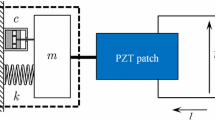Abstract
Fixture faults have been identified as a principal root cause of defective products in assembly lines; however, there exists a lack of fast and accurate monitoring tools to detect fixture fault damage. Locating fixture damage causes a decrease in product quality and production throughput due to the extensive work required to detect and diagnosis a faulty fixture. In this paper, a unique algorithm is proposed for fixture fault monitoring based on the use of autoregressive models and previously developed piezoelectric impedance fixture sensors. The monitoring method allows for the detection of changes within a system without the need for healthy references. The new method also has the capability to quantify deterioration with respect to a calibrated value. Deterioration prognosis can then be facilitated for structural integrity predictions and maintenance purposes based on the quantified deterioration and forecasting algorithms. The proposed robust methodology is proven to be effective on an experimental setup for monitoring damage in locating fixtures. Fixture wear and failure are successfully detected by the methodology, and fixture structural integrity prognosis is initiated.
Similar content being viewed by others
References
Ayres J. W., Lalande F., Chaudhry Z., Rogers C. A. (1998) Qualitative impedance-based health monitoring of civil infrastructures. Smart Materials and Structures 7(5): 599–605. doi:10.1088/0964-1726/7/5/004
Bhalla, S., Naidu, A. S. K., Ong, C. W., & Soh, C. K. (2002). Practical issues in the implementation of electromechanical impedance technique for NDE. In Proceedings of the SPIE international symposium on smart materials, nano-, and micro-smart systems, December 16–18, Melbourne, Australia: Paper 4935-77.
Blevins R. D. (2001) Formulas for natural frequencies and mode shape. Krieger Publishing Co, Malabar
Ceglarek D., Shi J. (1995) Dimensional variation reduction for automotive body assembly. Manufacturing Review 8: 139–154
Dreyer J. T., Pandit S. M., Bett T. A., Milbrodt P., Ungpiyakul T. (2006) Application of data dependent systems modeling to failure prediction in non-stationary manufacturing processes. Transactions of NAMRI/SME 34: 461–468
Giurgiutiu V., Rogers C. (2003) Active sensors for health monitoring of aging aerospace structures. International Journal of Condition Monitoring and Diagnostic Engineering Management 6(1): 3–21
Giurgiutiu V., Zagrai A. (2005) Damage detection in thin plates and aerospace structures with the electro-mechanical impedance method. Structural Health Monitoring-an International Journal 4(2): 99–118. doi:10.1177/1475921705049752
Grisso, B. L. (2004). Considerations of the impedance method, wave propagation, and wireless systems for structural health monitoring. In Mechanical Engineering (p. 108). Blacksburg, VA: Virginia Tech.
Gyekenyesi, A. L., Martin, R. E., Sawicki, J. T., & Baaklini, G. Y. (2005). Damage assessment of aerospace structural components by impedance based health monitoring. NASA Technical Report 213579.
Lalande, F., Rogers, C. A., Childs, B., Chaudhry, Z. (1996). High-frequency impedance analysis for NDE of complex precision parts (pp. 237–243). Bellingham, WA: SPIE—Smart Structures and Materials.
Nair, K. K., et al. (2003). Application of time series analysis in structural damage evaluation. In Proceedings of the international conference on structural health monitoring. Tokyo, Japan
Pandit S. M., Wu S. M. (1983) Time series and system analysis with applications. Wiley, New York
Pandit S. M., Paul D., Roth J. T. (1996) Monitoring and diagnosis of bearing defects using data dependent systems. Journal of Integrated Computer-Aided Engineering 3(4): 268–278
Park G., Cudney H., Inman D. J. (2000) Impedance-based health monitoring of civil structural components. ASCE: Journal of Infrastructure Material Systems and Structures 11(6): 448–455
Park G., Cudney H., Inman D. J. (2003) Overview of piezoelectric impedance-based health monitoring and path forward. The Shock and Vibration Digest 35(6): 451–463. doi:10.1177/05831024030356001
Peairs D. M., Park G., Inman D. J. (2004) Improving accessibility of the impedance-based structural health monitoring method. Journal of Intelligent Material Systems and Structures 15(2): 129–139. doi:10.1177/1045389X04039914
Rickli J.L., Camelio J.A. (2009) Damage detection in assembly fixtures using non-destructive electromechanical impedance sensors and multivariate statistics. The International Journal of Advanced Manufacturing Technology, 42(9–10): 1005–1015
Rickli, J., & Camelio, J. (2007). Monitoring and diagnosis of assembly fixture faults using multivariate control charts and surface scanning content. In Proceedings of manufacturing science and engineering conference 2007. October 15–18, Atlanta, Georgia.
Roth J. T., Pandit S. M. (1999) Monitoring end-mill wear and predicting tool failure using accelerometers. ASME Journal of Manufacturing Science and Engineering 121: 559–566. doi:10.1115/1.2833054
Simmers, G. E., Jr. (2005). Impedance-based structural health monitoring to detect corrosion. Virginia Polytechnic Institute and State University Thesis.
Suprock C. A., Roth J. T., Downey L. M. (2007) Real-time failure forecasting for flat, ball-nose, roughing, and tapered endmills using an accelerometer. Transactions of NAMRI/SME 35: 185–192
Sutherland J. W., O’Brien D. J., Wagner M. S. (1989) An algorithm for the detection of flute breakage in a peripheral end milling process. Transactions of NAMRI/SME 17: 141–151
Thien, A. B. (2006). Pipeline structural health monitoring using macro-fiber composite active sensors. Los Alamos National Laboratory (LANL) Thesis/Dissertation
Tseng K. K.-H., Naidu A. S. K. (2002) Non-parametric damage detection and characterization using smart piezoceramic material. Smart Materials and Structures 11(3): 317–329. doi:10.1088/0964-1726/11/3/301
Author information
Authors and Affiliations
Corresponding author
Rights and permissions
About this article
Cite this article
Rickli, J.L., Camelio, J.A., Dreyer, J.T. et al. Fault detection and prognosis of assembly locating systems using piezoelectric transducers. J Intell Manuf 22, 909–918 (2011). https://doi.org/10.1007/s10845-009-0366-7
Received:
Accepted:
Published:
Issue Date:
DOI: https://doi.org/10.1007/s10845-009-0366-7




